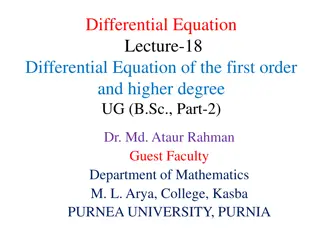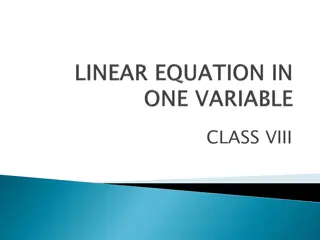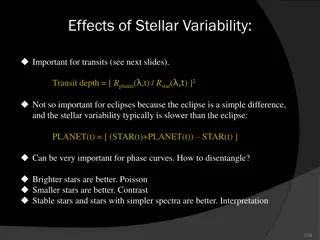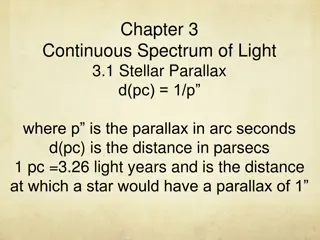Understanding Jeans Equations in Stellar Dynamics
The Jeans Equations and Collisionless Boltzmann Equation play a crucial role in describing the distribution of stars in a gravitational potential. By applying assumptions like axial symmetry and spherical symmetry, these equations provide insights into the behavior of large systems of stars. Despite the challenges in obtaining unique solutions, studying the velocity moments and simplifying assumptions can lead to practical applications. These equations are fundamental in stellar dynamics and are extensively used in astrophysics research.
Download Presentation

Please find below an Image/Link to download the presentation.
The content on the website is provided AS IS for your information and personal use only. It may not be sold, licensed, or shared on other websites without obtaining consent from the author. Download presentation by click this link. If you encounter any issues during the download, it is possible that the publisher has removed the file from their server.
E N D
Presentation Transcript
Jeans Equations See Cappellari MNRAS 2008
Collisionless Boltzman Eq The positions x and velocities v of a large system of stars can be described by the distribution function (DF) f(x, v). When the system is in a steady state under the gravitational influence of a smooth potential , the DF must satisfy the fundamental equation of stellar dynamics, the steady-state collisionless Boltzmann equation (Binney & Tremaine 1987, hereafter BT; equation [4-13b])
Collisionless Boltzman Eq Since f is a function of six variables, an infinite family of solutions satisfies equation Need additional assumptions and simplifications for a practical application of the equation. classic way of constraining the problem consists of drastically reducing it, from that of recovering the DF, studying the the velocity moments of the DF. This approach leads to the Jeans equations,
Jeans Equations Assume axial symmetry, cylindrical coordinates (R,z, ) and = f/ =0 can re-cast the Boltzmann eq as where vr,vz and v are velocities in the r,z and directions
Jeans Equations Then multiplying this equation by v vr and vz and integrating over all velocities one obtains the Jeans eq (BT 4-29) where is the number density Assuming steady state hydrodynamical equilibrium (all time derivatives are zero) and spherical symmetry implies v = v = 0
Jeans Equations However these equations are still a function of 4 unknowns and getting a unique solution is difficult \























